Vickers Viscount Network
July 2012 Newsletter
Dear Member
Welcome to the July 2012 Vickers Viscount Network newsletter. Firstly, the editorial team says thank you for the enthusiastic responses received
from many of you regarding the May newsletter.
We are sorry about the long but necessary absence of this newsletter while much needed site maintenance took place. Hopefully those annoying site
crashes have been cured. Please keep your news and pictures coming in and we will integrate what we can with information we have been storing.
We hope you will appreciate the magnificent work webmaster Geoff Blampied has done to enhance our site’s appearance and ease of access.
To see what has been achieved take a look back at our website in March 2007 and compare what you see with today website. Also try our new 'Time travel'
feature - it will bring back some great memories of times past. And as always, feel free to suggest further improvements.
 The Vickers Viscount Network in March 2007
The Vickers Viscount Network in March 2007
 Time travel feature
Time travel feature
Have a look around the our site on those "nothing on telly" occasions - there are many avenues to explore. Try starting with 'In the beginning'.
 In the beginning – how the Viscount began
In the beginning – how the Viscount began
 Our full contact details
Our full contact details
Thank you those of you who advised Geoff of your contact detail errors. He realised some of you were 'in wrong geographical places', for which
we apologise. Our 'family' has expanded immensely since implementation in 2005 and the newsletter is now circulated to over 800 people globally.
The British Library website archive service
The Vickers Viscount Network has been invited to submit our website to the British Library for regular archiving. An impression of our website
will be taken at least once a year and will be stored for all time in the British Library website archive. The British Library aims to keep
copies of websites that illustrate the life and times of the people of Britain throughout the ages.
These impressions are only available via the British Library website and are not to be found via search engines as this would clash with
results from the 'live' website. Only appropriate websites are invited to participate in the web archiving project so it is a great honour that
we have been chosen.
While looking at the British Library website Geoff found their main web page, which led to finding some interesting Viscount documents.
Our founders Geoff Blampied and Brian Burrage thank everyone who has helped make the Vickers Viscount Network the success it has become.
 The British Library
The British Library
2012 Vickers Viscount Network get-together
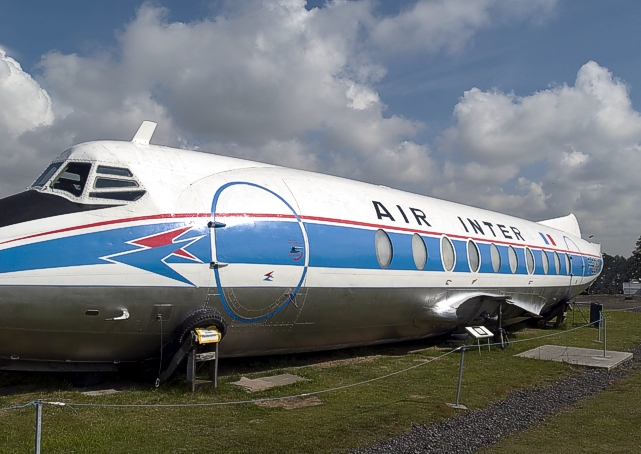
Viscount c/n 35 F-BGNR at Coventry after a fresh coat of paint
The proposed Vickers Viscount Network get-together at MAM - Midland Air Museum, Coventry, England this September has been postponed but for a
positive reason. The restoration of Viscount c/n 35 F-BGNR will have reached a critical stage by that time as the fuselage should be up on jacks
to have the wings refitted.
Although it would be exciting to watch, the museum would rather not have a group of keen supporters in close proximity while the work takes place.
Core members Julian Bourn and Mike Higgins have decided that in view of this, we would postpone the get-together to
sometime in the first half of 2013 when the Viscount will be in a much safer shape to be appreciated by the members.
 History and photos of Viscount c/n 35 F-BGNR
History and photos of Viscount c/n 35 F-BGNR
Jim’s man-cave
Jim Griffith has supplied this photo of a Viscount First Officer’s seat and notes;-
"Attached is a photo of my man-cave in the basement of my home. The Viscount seat has the original upholstery underneath the outer covering
that my wife stitched up for my comfort. I notice that my seat frame is different from the one depicted in an earlier newsletter. It had a
rounded seat base whereas mine is square. I really couldn't give up my favourite computer chair in any case."
Does anyone else have a personal Viscount seat? Here’s the chance to get it in print.
Air Canada Viscount sales
Vickers Viscount Network historian Brian Burrage has asked for more details on Air Canada Viscount disposals in response to the
following from Terry Baker who continues to glean key information for us from TCA/Air Canada in-house publications.
In the 'Horizons' issue of July 1975 it states "In 1974 the aircraft were withdrawn from service and stored at Winnipeg, some to
be scrapped and others sold."
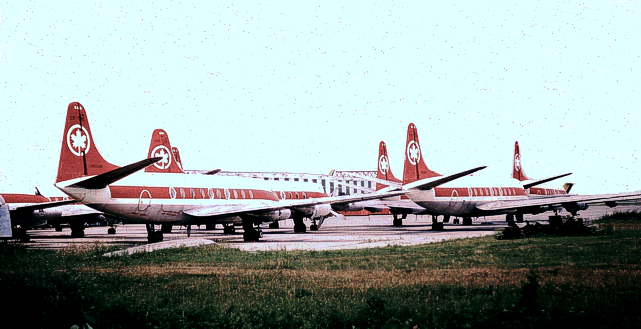
Air Canada Viscounts stored at Winnipeg, Manitoba, Canada in August 1975
Brian comments "Thanks for the scan of the 'Viscounts sold' news clip via our Canadian researcher Jack Stephens. As always, there are
some half-truths in it. 24 Viscounts sold is correct but my records show that not all of them were stored at Winnipeg. They were certainly
not all retired from service on the same day - 27 April 1974 relates to the sale/transfer to United Aircraft Services Ltd. (USAL)."
Brian is having difficulty in finding any information on United Aircraft Services Ltd. which may well have been an asset disposal company set
up by Air Canada. Other reports suggest that United Aircraft Services Ltd. and Beaver Enterprises are linked in some way, but he’s not
convinced Beaver Enterprises purchased the aircraft from UASL.
If anyone can shed more light on United Aircraft Services Ltd., or this mass disposal in general, then please let Brian know via the 'Contact
Us' menu option at the top of every page. He will be very grateful.
View Air Canada’s Viscount fleet by selecting Air Canada on the 'Owner or operator Viscount fleet lists' page.
 Owner or operator Viscount fleet lists
Owner or operator Viscount fleet lists
While still on Horizon . . . cartoonist – Dave Mathias
Doug Seagrim of the Montreal area, a former Air Canada Viscount pilot from 1965 – 1968, informs us that the TCA - Trans-Canada Air
Lines cartoon in our August 2011 newsletter was done by Dave Mathias who was a Station Manager in Europe for TCA.
Dave published a small booklet of his cartoons, many of which were featured in the TCA/Air Canada internal news called 'Between Ourselves'
which later became 'Horizons'.
 More TCA - Trans-Canada Air Lines cartoons
More TCA - Trans-Canada Air Lines cartoons
Paper weight
Tom Blanck writes, "I have had on my desk for many years a paperweight - a well-crafted silver model of a Vanguard. It once had a base because it has threaded holes
on the bottom side. It is about 10 inches long of either sterling or sterling plate (an applied layer of silver). I’ve always thought it was the sort of desk curio
that might have gone to the purchasers of the plane. It is marked with a small “s” on the underside. Do you know more about it?”
Dave Peters supplied a photo of a TCA - Trans-Canada Air Lines 1950s ashtray, noting, "The photo is of a Trans-Canada Air Lines
Viscount ashtray. With the stand and ashtray removed, does it resemble your Vanguard paper weight Tom?"
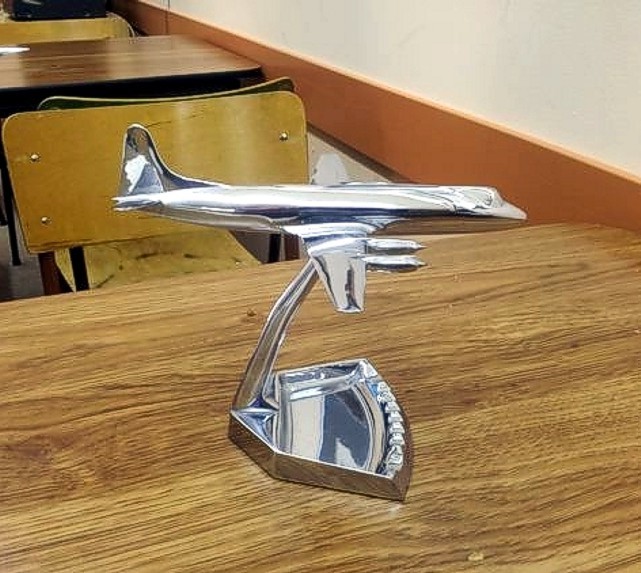
Dave Peters's TCA - Trans-Canada Air Lines ashtray
Building on our 5,000th photograph milestone
In our May newsletter we announced the loading of our 5,000th Viscount photograph. Have a look at our photo pages by construction number,
registration, or owner/operator and grab your 'shoe box' and see if it contains any Viscount related photographs that could be loaded on
to our website. Consider the following;-
Do I have a photograph of a Viscount in a livery not yet on the website? Note our plea elsewhere about Viscount c/n 319 PV-MVK.
So.... do I have a photo with unidentifiable people? The larger our network becomes the chances improve that someone can help.
Similarly, are there names I can provide for photographs already on the site? Have a look at the photo below of Mutt Summers and
Captain Wakelin. Can you tell us Captain Wakelin’s first name? Sometimes those 'nameless' people may still be alive and this creates
an opportunity to encourage them to join us to share their stories.
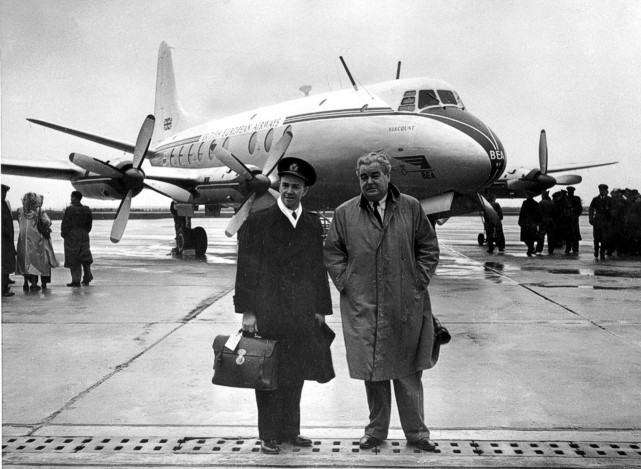
Captain Wakelin and Mutt Summers in front of Viscount c/n 1 G-AHRF
Ideally when submitting photographs, if you do have the details please include:-
The Viscount’s identity.
The location.
The date the photograph was taken.
Any particular significance of the photograph
The photographer’s name.
The contributor’s or the collection’s name.
The names of people in the photograph.
However if you do not have any of the above please still summit your photo and we will do our best to fill in what we can.
In case you are unaware, each photo when uploaded to the site is placed simultaneously on all its applicable pages, for example, the
aircraft’s registration and constructor’s number page, the applicable operator’s page and the contributor’s page. In addition, it may
also get used on a feature page such as an event be it a Museum visit or in a standalone story.
Paul Purser’s photograph collection
Paul Purser contacted us and drawn attention to his extensive photographic collection.
"Being fairly organised, I note that I have over 200 photos of Viscounts, mostly taken at Southend, Essex. About 95% of these photos are
of my original ownership. Not all are particularly good quality either. If any aircraft from the list are of particular interest, I'll scan
and upload them."
Geoff Blampied replied, "The convention we use for credits on our website is to use, for example ‘Paul Purser Collection’, to allow
you to send photos in your collection that were not taken by you. If you know the name of the photographer or collection the photo came from,
we can use that if you wish".
 Viscount photos by contributor
Viscount photos by contributor
Australian Viscounts – pre Ansett-ANA c/n 319 and c/n 355
Fred Niven of Australia, who has specialised in Australian Aviation history (particularly Ansett), wrote;-
"I’m seeking digital photos of two Viscount V.800s before they joined Ansett-ANA. C/n 355 Viscount V.812 N241V of Continental Airlines (later
VH-RMK) and c/n 319 Viscount V.818 CU-T623 of CUBANA (later VH-RML). Photos of both aircraft appear to be as rare as hens' teeth – CU-T623
being understandable, but N241V, I would have thought less so. Can anyone assist please?"
Brian Burrage, our photo archivist, has subsequently supplied Fred with two photos of N241V and a photo of CU-T623 that has
been supplied by Peter Upton.
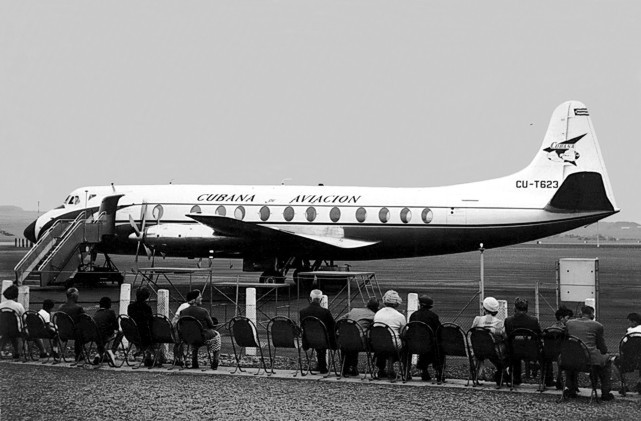
Viscount c/n 319 as CU-T623 of CUBANA
We know the photo of CU-T623 was taken at Prestwick but at this stage we do not know the actual date it was taken. Are the deck chairs of any
particular significance, such as a handing over ceremony? The aircraft arrived in Cuba on 20 August 1959.
Does anyone out there have further photos of these aircraft that we can add to our website? In particular we would like to add photos of
Viscount c/n 319 in FAT - Far East Air Transport and Asia Aviation Services liveries. If you can help in any way, please contact us:
 E-mail us - information@VickersViscount.net
E-mail us - information@VickersViscount.net
The most recent photo we have for Viscount c/n 319 is in Merpati Nusantara Airlines livery as PK-MVK.
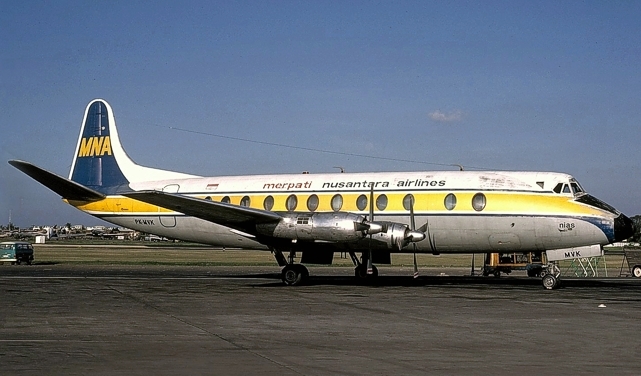
Viscount c/n 319 as PK-MVK of Merpati Nusantara Airlines
 History and photos of Viscount c/n 319 CU-T623 / VH-RML / B-2019 / PK-MVK
History and photos of Viscount c/n 319 CU-T623 / VH-RML / B-2019 / PK-MVK
Redundant Viscount D-ANAF - where shall I wander?
A few months ago we were alerted to concerns about V.814 Viscount c/n 447 D-ANAF, which is about to be replaced as a ground trainer at
Frankfurt Airport by Boeing 737-530 D-ABJI. As Brian Burrage points out, it seems early for a Boeing 737-500 to be replaced but
more importantly, what is to happen to the Viscount? Brian ponders the possibility of it going to a museum near Darmstadt and is
contacting someone he knows from Lufthansa.
Core member Colville Wemyss has also drawn our attention to the following Google alert
 Google alert: 737-500 to replace Vickers Viscount
Google alert: 737-500 to replace Vickers Viscount
Thank you to everyone who drew this to our attention and those of you who are following up on its fate. We must look on these pieces of
information as steps to ensure preservation. In other words, if we ignore the warning signs, then the Viscount could become all but a memory.
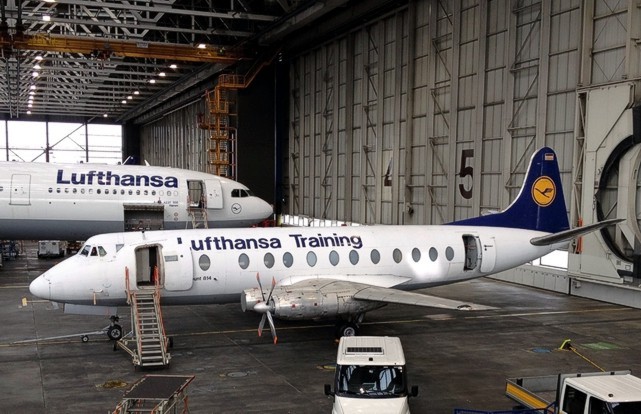
Viscount c/n 447 D-ANAF alongside an Airbus A330 in the hangar at Frankfurt
Just recently we received more information about this aircraft. Malcolm Ginsberg, Editor in Chief of AERBT - an Executive Review
of Business Travel, has alerted us to the following from Alan Lathan.
"I was surprised when I saw her pulled into the hangar 3 days ago. An in-house camera man was going to make a movie about the 60 years of
Lufthansa technical training and stated that she was still useful for various training tasks, such as wheel changes and such like."
The photo above, taken on the 16 May 2012, was provided by Alan with sufficient information for us to update the aircraft’s history on
our website. More great pictures of this aircraft can be found on its photo pages.
 History and photos of Viscount c/n 447 D-ANAF
History and photos of Viscount c/n 447 D-ANAF
 Organisations with complete Viscount airframes
Organisations with complete Viscount airframes
The situation doesn’t get much better than having an assembled survivor and one day D-ANAF may appear on the above link page in the care
of a museum! Are you aware of other candidates for this page?
Again, we hasten to add that we are pretty certain there are no airworthy Viscounts anywhere. When you look at examples such as D-ANAF
you may wonder why there aren’t but the costs are surely a major factor. Imagine for a moment if there are four suitable operational Dart
engines out there, which could be fitted to this aircraft. Expand on that; what other missing essential items exist that can be sourced?
Viscount c/n 375 SE-IVY still exists after all
In a similar vein core member Simon Ellwood has some good news.
"I was looking at the 'Old Props' website and noticed that the site's guestbook had an entry from a fellow who claims that Viscount c/n
375 SE-IVY was NOT in fact scrapped after being damaged by fire circa 2001 whilst mounted on poles above the ‘High Chaparral Wild West
Theme Park’, Sweden. He says it was still present when he visited in 2006.
Indeed, after searching for a short time on Google Earth, the Viscount is still visible mounted in place in the latest shots from 2009.
Another Viscount lives on!"
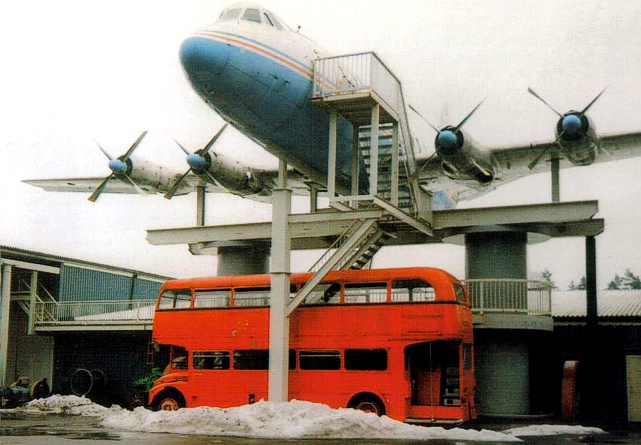
Viscount c/n 375 SE-IVY at the High Chaparral Wild West Theme Park
Brian Burrage notes, "I’ve changed the website history and photo for this aircraft and also changed the location to 'near Kulltorp,
Sweden' as this more accurately describes the location.
For those who want to find it on Google Earth, put in Kulltorp, Sweden and the aircraft is southwest from the Google Earth place marker.
The aircraft is rather faint but nonetheless visible.
We still don't know which airfield she finally landed at before being dismantled and moved to the theme park. Gothenburg Airport seems a
long way away. Perhaps there is a smaller airfield nearby suitable for an empty Viscount to land on?"
 History and photos of Viscount c/n 375 SE-IVY
History and photos of Viscount c/n 375 SE-IVY
"I remember Gothenburg... from way back"
Viscount test pilot and core member Brian Powell recalls
"I was reading your correspondence about the location of Viscount c/n 375 in which you discussed the possibility of an airfield
adjacent to Gothenburg.
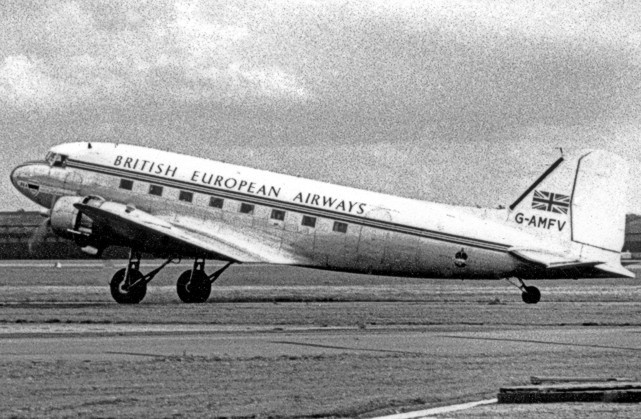
A Douglas DC-3/Dakota like the one in Brian Powell's story
I remember - for what it’s worth - a charter flight there in a DC-3 in 1946. In those days, before the publishing of 'Aerad' or 'Jeppesen'
airfield charts, the pre-flight briefing room at Croydon (operated by the Air Ministry) gave no other information about the airfield at
Gothenburg than its latitude and longitude. Indeed, there were no landing aids or ADF beacons.
I broke cloud and arrived in visual conditions, spotted the airfield at the prescribed location and reported 'down-wind' on the only
frequency then in use, 118.10MHz, and was told that I was 'No. 2 to land after an aircraft on finals'. Despite a thorough search there
was no traffic visible ahead, so I continued; reported 'on finals' and duly received landing clearance.
Having landed, there was little to observe except some fighter aircraft located in individual protected bunkers hewn in the rocks
surrounding the perimeter. I called up for ‘taxi instructions’. There was a pause in communication before the reply. The instruction
then came 'You have landed at a military airfield. Draw the cabin blinds, back-track, take off and steer… degrees… miles to the civil
airfield'.
The latitude and longitude of the civil airfield, which had only recently been constructed, was as yet unknown to the Air Ministry
briefing room at Croydon! They were kind, forgiving and not a little amused when I explained the reason for the mistake.
Happy pioneering days!"
Not to be out done Brian Burrage has a similar tale to tell.
"We sent a Dart salesman to West Air Sweden in the 1990s when they started buying HS748's for freight use. He flew to Gothenburg and
hired a car and went to the town nearest to the customer and checked into a hotel.
In the morning he called the customer to say that he would be with them in about half an hour and told them which hotel he was staying
at. They laughed and said 'See you in about three hours'! He had gone to Linkoping instead of Lidkoping and there is a massive lake in
between".
 Airport Guides - Gothenburg today
Airport Guides - Gothenburg today
Share your experience - pressurisation malfunction
Brian Powell shares with us another of his precious recollections from his Viscount days.
"I was seconded to Eagle Aviation Ltd. to do the initial training of eight of their pilots on their first V.805 Viscount c/n 258 G-APDW.
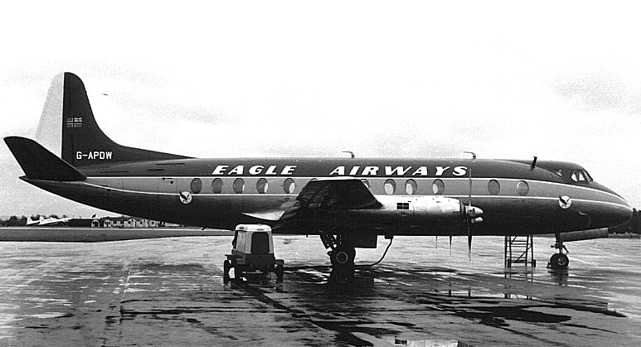
G-APDW in January 1958, about the time that Brian was training their pilots
After the initial base-training the first route flight was to carry a passenger compliment of skiers from LAP - London Air Port to Munich
on 4 January 1958.
It was a night of foul weather, thick cloud and snowing. I, in a training capacity, was seated in the jump-seat with the Eagle Captain
and First Officer in their respective seats.
In the cruise over north Germany we had a pressurisation malfunction unmistakably detected by a sudden increase of pressure on the
eustachian tubes. A quick glance at the cabin pressure indication confirmed that the cabin pressure was increasing rapidly and approaching
its maximum permissible limit.
It’s difficult to analyse one’s thought processes on such an occasion. They must have gone through my mind in milli-seconds. Would the
safety valve blow off to save the structure from over-pressurisation? At that stage I wasn’t prepared to trust it! The pressurising air
came from bleeds in the compressors of numbers 2, 3 & 4 engines. It was fed in through cut-off valves; but these were specifically designed
to be slow enough in operation to obviate cabin pressure surges - taking some two or three minutes to operate from 'open' to 'close'.
There was only one way to cut off the pressurisation air supply quickly – it was to stop the engines. There wasn’t time to explain this to
the Eagle crew. I shut the HP cocks on those three engines, pressed the feathering buttons; and instructed them to get down to ten thousand
feet asap for passenger comfort, and inform Air Traffic Control accordingly.
Only then did I have time to explain my thoughts. They said later that they thought I had taken leave of my senses!
As soon as the pressurisation valves had inched closed we were then able to re-start the three engines and we completed the flight to
Munich unpressurised. Fortunately it was the first charter of the season so we had no passengers for the return flight and we ferried the
aircraft home unpressurised.
I was told later that the fault had been due to water condensation in the static line to the pressurisation controller. The line had been
routed close to the skin at one point and had been blocked by the ice. I understand that a modification was done later to re-route the
static line."
A great story from Brian that perfectly illustrates aviation in the 1950s. We want to hear more true and relevant stories, which at the
time may even have been, or seemed, serious or embarrassing. Then again, we all know of the advances in technology and when viewed in that
light, those moments may now be seen as avoidable. Hindsight is wonderful.
 History and photos of Viscount c/n 258 G-APDW
History and photos of Viscount c/n 258 G-APDW
We do not have a colour photo of G-APDW in Eagle’s livery. Can anyone help? If you visit its history page you will see it certainly had its share of moments before
retiring gracefully on 6 January 1970 only to face the axe.
More on engine fuel trimmers
Our Canadian researcher Robert Arnold reports
"I was having a quick re-read of a recent newsletter and I noticed the conversation on fuel trimming. Brian Burrage mentions a
chart that was supplied by Rolls Royce. Below is this chart taken from the flight manual of TCA - Trans-Canada Air Lines Viscount c/n 56
CF-TGS."
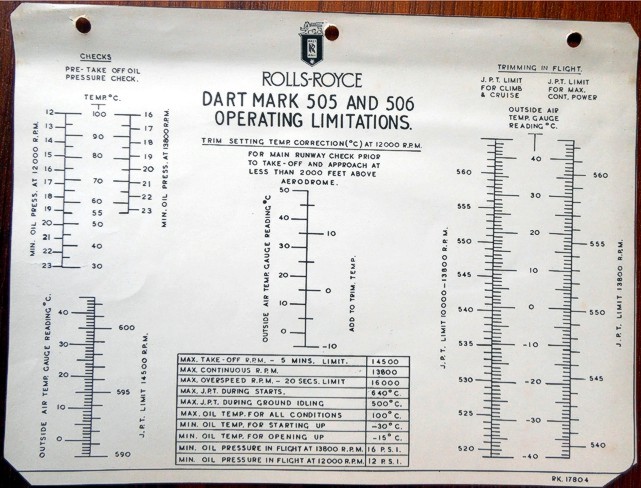
Rolls-Royce Dart mark 505 and 506 fuel trimming chart
'Houseploat' N764C c/n 104 didn’t have a bright future - a mystery solved
Vickers Viscount Network UK researcher Ed Jones reports
"I won the press photo below on eBay and it solves one of our mysteries, that of Viscount c/n 104 N764C's 'Bright future'."
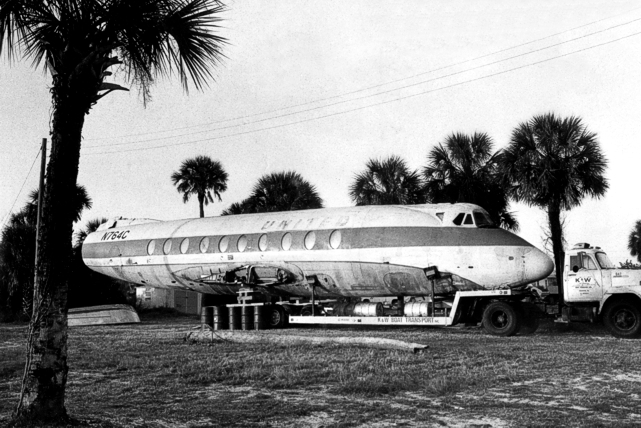
Viscount N764C after its arrival on the back of an articulated truck
"The fuselage was purchased by Alfred Homann of St Petersburg Beach. It was intended for use as a 'houseploat' (plane – boat)
moored in the marina. Unfortunately after years of work it was eventually scrapped.
All this data was found on the back of the photo. Interesting that someone had the thought of turning her into a floating house-boat;
I think it’s a first for the Viscount."
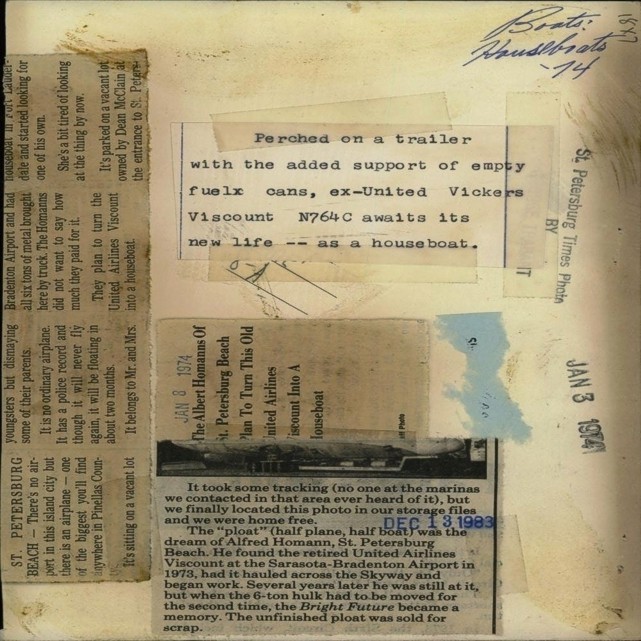
The back of Ed's photo
Where is Viscount XT661?
Brian Burrage has enquired about the current status of Viscount c/n 371 XT661.
The aircraft was broken up into sections by Hanningfield Metals at Thurleigh, Bedfordshire, England in July 1993 but the whereabouts of
the cockpit section, believed to still exist, remains a mystery. Does anyone have any further information?
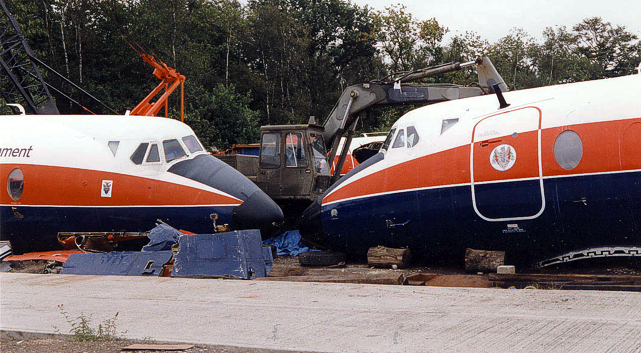
XT661 here on the left, discussing its pending fate with XT575 at Hanningfield Metals in 1993
 History and photos of Viscount c/n 371 XT661
History and photos of Viscount c/n 371 XT661
... and where is Viscount CF-THC?
Inquiries have also been made about the fate of the nose section of Viscount c/n 220 CF-THC. Robert Arnold has contacted Keith
Olson of Selkirk, Manitoba, Canada, the last known owner, who reports
"The nose section was sold, to whom I can't remember, 20 or more years ago to be used as a restaurant attraction. I will look around for
a bill of sale though I may not have got one."
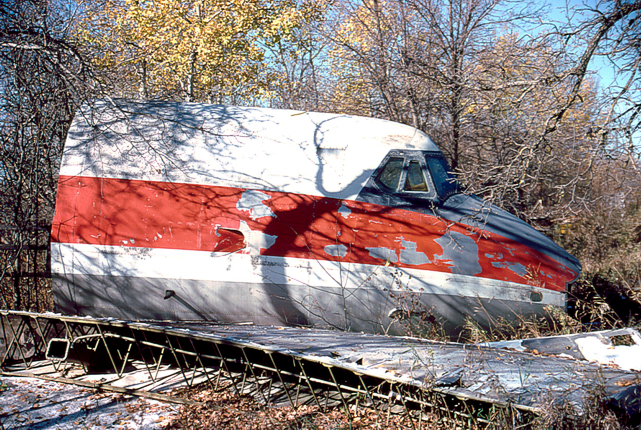
Viscount c/n 220 CF-THC nose circa 1992
 History and photos of Viscount c/n 220 CF-THC
History and photos of Viscount c/n 220 CF-THC
Does any of our Canadian readers remember seeing a Viscount nose section being used as in a restaurant setting? We would appreciate any
photos of it located anywhere after leaving Keith’s farm.
 If you can help please e-mail us at information@VickersViscount.net
If you can help please e-mail us at information@VickersViscount.net
How it all started – following a dream on 6 April 1959
Wayne Knight of Auckland, New Zealand, mentions that his introduction to the NAC Viscount led him, as a teenager, to following a
dream.
I lived in Palmerston North and can still vividly recall hearing the first Viscount flying over the city, en route to Milson (Palmerston
North) Airport. My Dad took me out to the airport to see it - I could hardly see above the boundary picket fence where I was in awe of
what was, and still is . . . one of my best-loved memories of any airliner.
I told Dad that one day I would fly around the world on something like that. From 27 years of age, and for the following 30+ years, I was
a flight attendant with Air New Zealand and so indulged in my childhood fantasy. They were, without doubt, the best days of my life,
brought about by that single occasion of hearing and then seeing the NAC Viscount at dear old Palmerston North Airport!"
Editor’s note: NAC merged with Air New Zealand in 1978. By chance, the late Doug Walker
photographed ZK-BRE c/n 282 City of Auckland that day at Christchurch, loading passengers for the inaugural service.
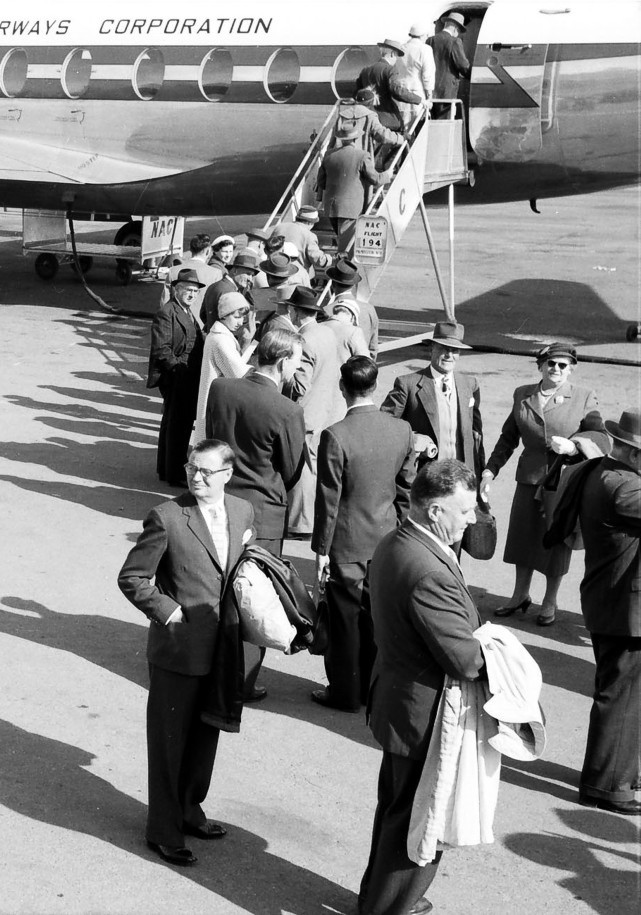
Viscount c/n 282 ZK-BRE loading passengers
The Robert W. Arnold Collection
Regular readers of our newsletter will know that Robert Arnold is toiling away at producing a book on Canadian Viscounts. He is a
happy man having recently acquired three substantial collections - the Wiklund Collection, the CAE Collection, and the Tony Morien
Collection. He explains
"These are all from the WCAM - Western Canada Aviation Museum archives. Keith Olsen was the contact person who had me in mind due
to his knowledge of my involvement with the Vickers Viscount Network and my passion for preserving anything Viscount.
The page below explains the story behind the entire Wiklund Collection. I received the Viscount section, which alone has about 19 boxes
of blueprint drawings. It has been fully documented so finding a blueprint by number shouldn't be too difficult. I also received a
further five Wiklund boxes so I have to figure out what is in those."
"The CAE and Tony Morien collections are completely separate. I also received a few miscellaneous items from the museum's collection.
These 3 collections now all became the Robert W. Arnold Collection as of 4 February 2012.
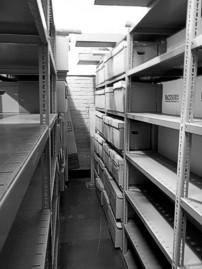
Robert's archive
I am fortunate to have a friend who was willing to allow me to store all 65 boxes plus 15 bags of files in his garage. The bonus is,
he lives less than a block away."
An update . . .
"An update on what I have secured from the WCAM. The 24 boxes you see on the right are from the Wiklund Collection.
These boxes contain nothing but Viscount blueprints.
These are just part of what I now have in my collection. I took photos of all the boxes and bags now in my possession. Again, thought
you might want to know."
. . . and then there’s more
"I also have a cache of various types of Viscount paper work that Tony Morien had at his residence until he passed away a
few years ago."
Gosh Robert, you must have Viscount data coming out the ears! Clearly there is a wealth of material here and no doubt, in time, this
will become a great resource for the Vickers Viscount Network for many years to come.
An interesting point – what happens when?
Jack Stephens makes an interesting comment following on from Robert's above announcement.
"We have learned that aircraft museums are not always the safest place, for example your new found collection, and yet this is the most
logical. Perhaps contacting historical societies would be worth exploring. To work hard at collecting Viscount material, and then not
ensuring to the best of one's ability to make provision in the event of death, would be like not having a will. Does any members have any
suggestions?"
Good point Jack. Any suggestions should be sent to
 E-mail us at information@VickersViscount.net
E-mail us at information@VickersViscount.net
Painting restoration - Viscount CF-TGT
Also via Jack Stephens we became aware that Jim Bruce has restored a slide of an old painting. The following is the e-mail
correspondence which flowed.
From Jim; "I found an old slide of a watercolour painting I did from the B/W photo I sent you of the line maintenance hangar Viscount
c/n 57 CF-TGT #612.
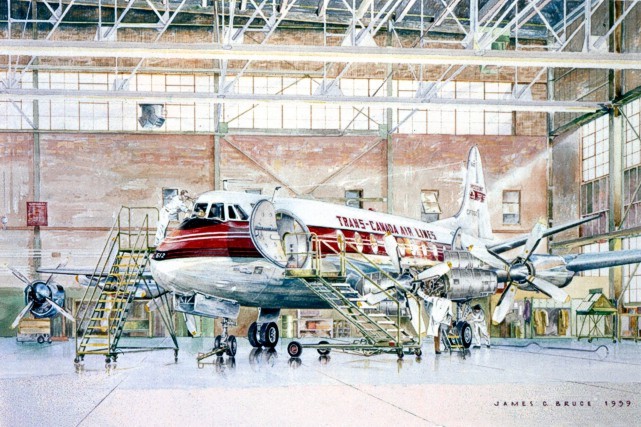
Jim Bruce's painting of the TCA - Trans-Canada Air Lines Viscount CF-TGT
The 1959 slide has faded badly but I was able to restore the colour with a software programme. I also removed hundreds of little dirt
marks; took about 3 hours! I think it looks pretty good. I don't know where the original is. Got lost between WPM and UL I guess. Or I
may have given it to a TCA 1011 captain I knew.
I still have the TransAir watercolour from the same period so I include it also."
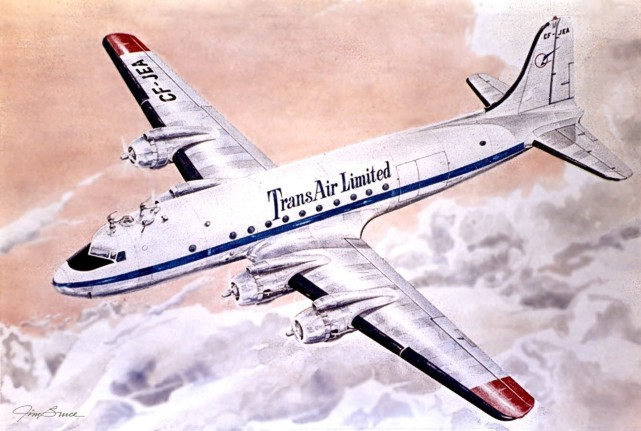
Jim Bruce's painting of the TransAir Douglas DC-4 CF-JEA
Jack replied, "What a pleasant surprise! On behalf of all of us at the Vickers Viscount Network, we appreciate your time and effort into
restoring the painting. It looks very good!
As you know we have your B/W photo on our website under the Jim Bruce Collection. For some years now we have enjoyed your unique painting
of CF-TGQ engine run-up 'At the Blast Fence'."
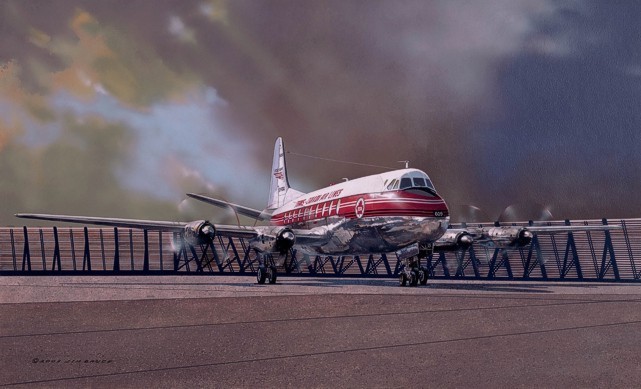
Jim Bruce's painting 'At the Blast Fence'
"I note that the hangar in your 'new' painting was known as the Line Maintenance Hangar. To the left can be seen a spare
Rolls-Royce Merlin engine awaiting the next DC-4 North Star. It appears the aircraft is having a main wheel changed.
Thanks for the TransAir painting. We have been discussing CF-TGI's service with that airline so the painting of the DC-4 is quite timely.
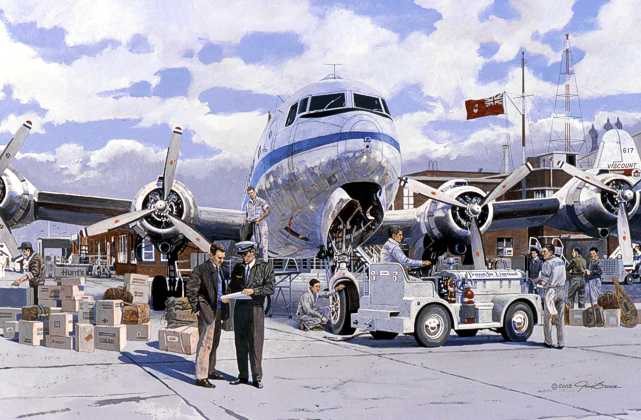
Jim Bruce's painting 'TransAir Pre-Flight'
"Let me quote what you wrote about the aircraft when you sent us your first painting of CF-JEA.
'The famous Douglas DC-4 CF-JEA of Winnipeg-based TransAir is shown during departure preparations at Winnipeg's Stevenson Field in 1957.
TransAir (1955-1977) was an important regional carrier and was involved in flying support for the DEW (distant early warning) line and
mid-Canada line at this time.
CF-JEA flew for 14 years with the carrier and did a weekly Montreal-Ottawa-Winnisk-Churchill-Winnipeg run. It ended up in California
where it was scrapped in 1974.'
Norm Penner confirms that TCA - Trans-Canada Air Lines Viscount c/n 40 CF-TGI was on a schedule to Churchill. Makes one wonder if
the two aircraft ever parked together?"
Home of the BAC 1-11 on the web
Peter Clark, webmaster of the BAC 1-11 website is suitably impressed with our site (thanks Peter) and has approached Geoff
Blampied our webmaster for guidance on his site’s enhancements, and notes that 2013 marks the 50th anniversary of the BAC 1-11’s
introduction. The BAC 1-11 was designed as a Viscount replacement.
Peter introduces himself, "I’ve been interested in the BAC 1-11 since I toured the production line in 1978. I helped organise the type’s 25th, 40th and 45th
anniversaries and am currently trying to ensure that the very last flying 1-11 left in the UK is preserved for the nation!
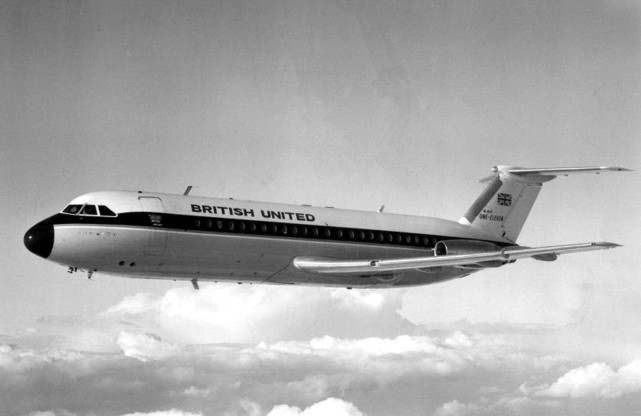
BUA - British United Airlines BAC 1-11 G-ASHG taken on the 4 October 1963
I’ve been running the website for over ten years with much assistance from 1-11 specialist Richard Church, author of 'The One-Eleven Story' by Air
Britain.
I fly commercial jets for a living, having started out with Air UK flying Fokker F-27s, Fokker 50s and Fokker 100s. My present employer is Monarch Airlines
where I’ve been at London (Gatwick) for the past 13 years, flying the Airbus A300, A320 and A321.
I run a separate BAC 1-11 forum at Yahoo Groups with over 400 members but it would be great to bring this in-house. I would be particularly interested in
accessing some of those photographers who have contributed to your site as I’m sure many of them would have some 1-11 images for example or information of
general interest to the my site. Any help that you might be able to give me would be much appreciated."
There you go – if you feel you can help Peter, who has now become a Vickers Viscount Network core member, please e-mail him.
 Peter.Clark@VickersViscount.net
Peter.Clark@VickersViscount.net
 Home of the BAC 1-11 on the web
Home of the BAC 1-11 on the web
More Viscount memories
Core member Rory Kay posted a message on the retired Capital pilots' website. In response we’ve heard from Terry Davies,
who retired as a 747 captain in 1997. He recounts
"I had hoped to find a treasure trove at the Delaware Aviation Museum at the Sussex County Airport in Georgetown, Delaware (GED).
NOTE: While the combination of letters GED is better known in the States as shorthand for General Education Development, a series of
tests that may be taken later in life by those who dropped out of high school and the passing of which certifies the equivalent of having
graduated from a standard high school, in this case it is used as the identifier for the airport.
I landed there in a light plane many years ago to await the passing of a summer thunderstorm and was surprised to see quite a few
Viscounts still in United Airlines livery parked on the ramp. However, when I called the museum to see if perhaps they had acquired one
for their collection, the person with whom I spoke said that they had all been purchased by a person or company that he referred to only
as Goldman and that they had been sold to outfits in South America. No further information was forthcoming.
I started at United as a Douglas DC-6 flight engineer in September 1966 and at that time, and for a while afterwards, United flew the
Viscount in the same category as the DC-6 for captains and co-pilots, though, as it had no flight engineer, my only contact was a
deadhead flight or two to cover a DC-6 trip out of a station served by the Viscount. I remember best the really big windows.
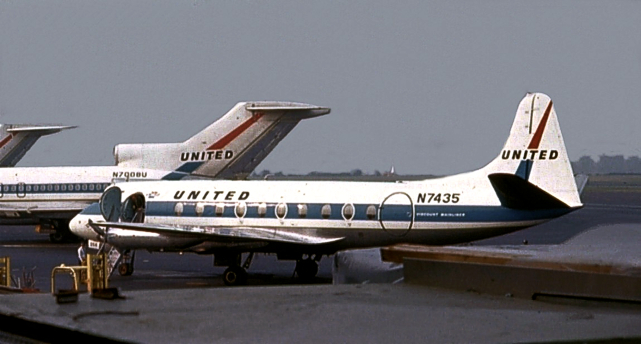
N7435 at Dulles in September 1966 - the same time Terry started as a United DC-6 flight engineer
I do recall as a teenager working a summer job at a filling station in Alexandria, VA, just south of what was then known as Washington
National Airport (now it has the name of Ronald Reagan worked in for the politically correct), and seeing Viscounts go by, climbing out
over the Potomac, with one engine feathered. This would have been in 1953 or 54. I later learned that these were training flights and
the check pilot had cut one engine just after V-1, taking off on Runway 18.
I am sorry that I have not been able to provide you with anything more than a little nostalgia but given the number of Viscount drivers
still alive and kicking in the RETUP group I suspect that it will not have been a dry hole for you."
Thank you Terry, snippets of information like this are always welcome. They do bring back memories and sometimes solve mysteries for
the Viscount readership, so thank you for contributing.
Another alert
Similarly, Jamie Popplewell has drawn this thread to our attention. As he says, "Have a read, this is a current thread I am
following on PPRuNe, read the post number 62, interesting story."
 PPRuNe Viscount thread
PPRuNe Viscount thread
Have a look at the pages of the thread. These are the sort of places where we can pick up useful information and track down further
interesting Viscount followers, outside our current circle. These are also the sort of places where we can pick errors in circulation
and have the chance to correct them. It would be nice to add some of those folk to the Viscount 'family'.
Letter from Australia
The TAA - Trans-Australia Airlines Viscount featured in the above advert has drawn attention from readers. Core member Allan Taylor
in Australia comments
"I doubt that this advert was placed by TAA but more likely by a local UK agent. Their statement that 'they own what they sell' was clearly
being economical with the truth. I know that these aircraft were also advertised for sale by Keegan Aviation amongst others.
They were also regularly advertised at the time in Flight magazine and Australian Flying magazine with an accompanying photo of most of the
V.700 series fleet lined up. The ones that were scrapped in Oz (all but 2) were sold by TAA which means that anybody else advertising them
were commission agents.
I also seriously doubt whether TAA would have made such glaring errors in the photo use and statement of seating capacity. Though it is a
nice advert, you will much prefer the one in Flight magazine if you can track it down.
I don’t know why they were ever advertised for sale within Australia as the Federal Government's two-airline policy prevented their use in
opposition to TAA or Ansett-ANA. The two RAAF Viscounts almost got to fly here as VH-EQP and VH-EQQ for Jetair Australia Pty Ltd, which was
a new airline formed to compete against the 'big two'."
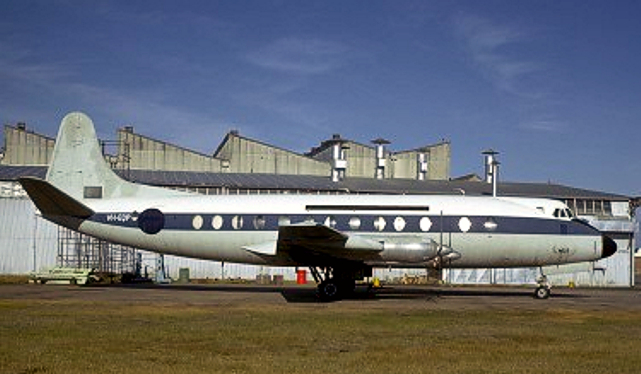
VH-EQP at an unknown location. Can someone please provide more details?
"The most effective control that the government had was in refusing to issue import licences to any aircraft that were deemed to threaten the
two-airline policy. Jetair had assembled quite a fleet of DC-3s, which were ex Oz airline aircraft but didn't need import licences because
they were already here. Their only other hurdle was to get approval to operate routes that were deemed to be not in competition with the 'big
two'.
There was a lot of political 'argy-bargy' behind the scenes by influential people to prevent a third operator. The two RAAF Viscounts were
sold overseas and expected to be flown out. Smarter minds were at work however and that company just happened to owe Jetair's backers quite
a bit of money, conveniently. So Jetair seized the two Viscounts as payment and registered them as VH-EQP and VH-EQQ respectively.
Since they were already in Australia, no import permits were required and Jetair almost succeeded in being a creditable challenger to the
two-airline policy. Eventually, ‘old mates’ politics saw Jetair shown the door.
Opposition to opposition was so bad at the time that it took IPEC years and a change of government to break into the Oz airfreight market.
A smaller company named Air Express was viewed with much suspicion by the authorities. It eventually gained a lot of respectability by
becoming a division of Mayne Nickless who were a large respected company.
They operated air freight out of Archerfield Airport in Brisbane with Bristol Freighters for years. These, like the Viscount, had a fatal
wing spar life that eventually damned them (in Australia). Since those days, revolution has happened and things are far better for aspiring
airline operators. Now you are officially permitted to go broke if you want to! Just a few more pieces for the jigsaw puzzle!"
We will be adding some more Australian Viscount notes from Allan in future newsletters.
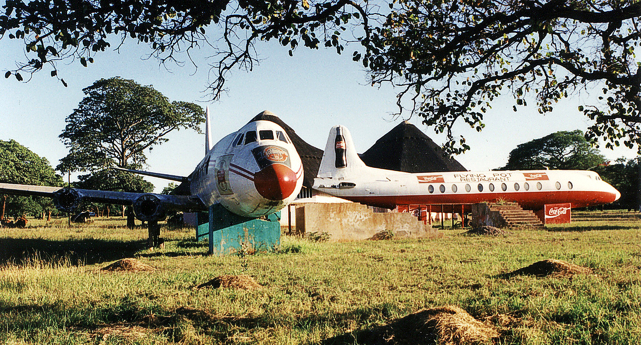
Viscounts Z-WGB & Z-WGC at Chegutu, near Harare, Zimbabwe
We currently do not have any photos of Viscount c/n 436 bearing the registration VH-EQQ. Can anyone help?
Viscount c/n 436 ended it's days as a restaurant in Chegutu, Zimbabwe as Z-WGB together with Viscount c/n 446 Z-WGC. Above is a comparatively
recent photo of c/n 436 as Z-WGB with the 'Flying Pot Restaurant' taken at Chegutu, 70 km southwest of Harare, Zimbabwe on the road to
Bulawayo with Viscount c/n 446 Z-WGC which is on the right. It appears to have a Coca Cola bottle logo on the tail.
 History and photos of Viscount c/n 436 VH-EQQ and Z-WGB
History and photos of Viscount c/n 436 VH-EQQ and Z-WGB
How to send us information and photos
To provide information and photos for inclusion in the Virtual Museum or our Newsletters, please send them to;-
 Membership@VickersViscount.net
Membership@VickersViscount.net
Photos should be scanned as a JPEG (.jpg) ideally producing an image of at least 600 KB to give us something to work from.
Scanning prints at 600 DPI and slides and negatives at 1,200 DPI usually produces good results.
Don't worry about the condition of your photos as we can work wonders with most images that have strange colours or dust
marks, blemishes etc.
Newsletter Editorial and Production Team
Peter Layne - Chief Editor, Wellington, New Zealand.
Ed Jones - Editor, Manchester, England.
Simon Ellwood - Newsletter Production, Leeds, England.
Geoff Blampied - Website Production, Norwich, England
Although every endeavour is made to find an answer to questions, please appreciate that the team here at the Vickers Viscount
Network are all unpaid volunteers who fit this work in with their daytime jobs and chores around home. Any opinions expressed
in this publication are not necessarily those of the Vickers Viscount Network or the Newsletter Editors.